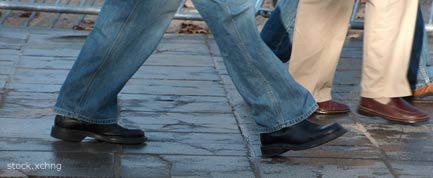First Shoes Worn 40,000 Years Ago

Humans started wearing shoes about 40,000 years ago, much earlier than previously thought, new anthropological research suggests.
As any good clothes horse knows, the right outfit speaks volumes about the person wearing it. Now, anthropologists are tapping into that knowledge base, looking for the physical changes caused by wearing shoes to figure out when footwear first became fashionable.
Turns out, clothes really do make the man (and the woman), at least when it comes to feet. That's because wearing shoes changes the way humans walk and how their bodies distribute weight. If you wear shoes regularly, as most modern humans do, those changes end up reflected in your bones and ligaments.
Susan Cachel, an anthropologist at Rutgers University in New Jersey, said science has known about the way wearing shoes affects feet since the early 20th century. Researchers have found several differences between feet that regularly wear shoes and those that don't.
For instance, wearing tight shoes can lead to bunions, which are painful enlargements of the bone or tissue in the big toe, she said. People who don't wear shoes have wider feet and bigger gaps between their big toe and the other four. And women who spend a lot of time in high heels wind up with smaller calf muscles.
Erik Trinkaus, an anthropologist at Washington University in St. Louis, was the first person to apply this understanding of how fashion alters physical bodies to anthropology. He found a point in human history where the size of toe bones began to shrink. Combining that data with knowledge of how shoes change the way people walk, Trinkaus reasoned that smaller toe bones meant people had started wearing shoes.
While the oldest surviving shoes are only about 10,000 years old, Trinkaus' discovery pushed the adoption of footwear back to almost 30,000 years ago. He published that research in 2005. Now, thanks to analysis set to be published in the July 2008 issue of the Journal of Archaeological Science, Trinkaus has found that humans were probably wearing shoes even earlier, about 40,000 years ago.
Sign up for the Live Science daily newsletter now
Get the world’s most fascinating discoveries delivered straight to your inbox.
Through thick and thin
Trinkaus' theory is based on a simple fact: Bone size isn't set in stone.
"Bone, at least to a certain extent, responds during a person's lifetime to the mechanical stresses placed on it," said Tim Weaver, a University of California, Davis, anthropologist. "If you work out at the gym, not only will your muscles get bigger, your bones will become thicker."
For most of their history, humans had big, thick toe bones. Trinkaus said this was because they were doing more walking, climbing and carrying than we do today. In fact, he said, all their leg bones were bigger as well, for the same reasons. This is true for both Neanderthals and the earliest modern humans.
But, around 40,000 years ago, that began to change. Trinkaus noticed that skeletons from this time period still had strong, thick leg bones, but their toes had suddenly gotten smaller. "They had wimpy toes," he said. "I tried to figure out what would take away stresses on the toes, but not the legs, and the answer was shoes."
First shoes, first tailors
While Weaver agrees with Trinkaus' theory, Cachel doesn't buy it. She pointed out that, not long after the time period Trinkaus looked at, humans apparently stopped being so active and all their limb bones, not just the toes, started to shrink.
"If the footbones are smaller, this probably reflects less walking and physical activity, rather than the invention of supportive footware," Cachel said.
Both Weaver and Cachel think that it would make sense for shoes to hit it big around the time Trinkaus thinks they did. Around 40,000 and 30,000 years ago, human culture went through a growth spurt.
"The archaeological record shows may changes, including the types of tools people were making and the first definite artwork, and the oldest needles for making clothing appear shortly afterward," Weaver said.
And Cachel said this was probably the time period where a population boom allowed for the first divisions of labor, meaning that, for the the first time, somebody could dedicate all their time to making better, more decorated clothing.
"It seems reasonable that there were changes in footwear around this time too," Weaver said, "But before Erik Trinkaus' study we didn't have any direct evidence."
- Video: The Exercise Gene
- Top 10 Useless Limbs (And Other Vestigial Organs)
- The Body Quiz












